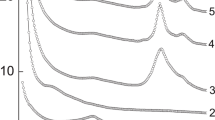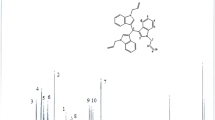Abstract
The objective of this work was to synthesize nanocomposites based on poly(N-vinylbenzyl-N-methyl-d-glucamine) and metallic nanoparticles, NP(VB-NMDG), from N-vinylbenzyl-N-methyl-d-glucamine (VbNMDG) and a polymerizable nanostructured crosslinker (PNC). PNC was synthesized from silver nanoparticles stabilized with acrylic acid and added to polymer phase during free-radical polymerization of VbNMDG. The boron retention properties of NP(VB-NMDG) were evaluated in function of pH and ionic strength. In addition, antimicrobial properties were evaluated against E. coli and S. aureus. Results evidenced that PNC can be synthesized by chemical reduction from Ag+, BH4− and acrylic acid as stabilizing agent. In addition, PNC can be added during the polymerization reaction to obtain NP(VB-NMDG). Effect of pH on boron retention of nanostructured polymer was significant only at low ionic strength (the order seen was pH 5.0 > 7.0 > 9.0). The ionic strength was identified to strongly decrease the boron retention by NP(VB-NMDG). Finally, NP(VB-NMDG) showed antimicrobial activity enhanced by incorporation of AgNPs.











Similar content being viewed by others
References
Guan Z, Lv J, Bai P, Guo X (2016) Boron removal from aqueous solutions by adsorption—a review. Desalination 383:29–37
Mahmoud M, Nallappan M, Ujang Z (2014) Polymer-based chelating adsorbents for the selective removal of boron from water and wastewater: a review. React Funct Polym 85:54–68
Wolska J, Bryjak M (2013) Methods for boron removal from aqueous solutions—a review. Desalination 310:18–24
Gazi M, Galli G, Bicak N (2008) The rapid boron uptake by multi-hydroxyl functional hairy polymers. Sep Purif Technol 62:484–488
Palencia M, Lerma L, Córdoba A (2016) Polyurethanes with boron retention properties for the development of agricultural fertilization smart systems. J Sci Technol Appl 1:39–52
Palencia M, Restrepo D, Combatt E (2016) Functional polymer from high molecular weight linear polyols and polyurethane-based crosslinking units: synthesis, characterization, and boron retention properties. J Appl Polym Sci 133:43895
Samatya S, Ali Tuncel S, Kabay N (2015) Boron removal from RO permeate of geothermal water by monodisperse poly(vinylbenzyl chloride-co-divinylbenzene) beads containing N-methyl-d-glucamine. Desalination 364:75–81
Zhang X, Wang J, Chen S, Bao Z, Xing H, Zhang Z, Su B, Yang Q, Yang Y, Ren Q (2017) A spherical N-methyl-d-glucamine-based hybrid adsorbent for highly efficient adsorption of boric acid from water. Sep Purif Technol 172:43–50
Palencia M, Vera M, Combatt C (2014) Polymer networks based in (4-Vinylbenzyl)-N-methyl-D-glucamine supported on microporous polypropylene layers with retention boron capacity. J Appl Polym Sci 131:40653
Palencia M, Vera M, Rivas B (2014) Modification of ultrafiltration membranes via interpenetrating polymer networks for removal of boron from aqueous solution. J Membr Sci 466:192–199
Nishihama S, Sumiyoshi Y, Ookubo T, Yoshizuka K (2013) Adsorption of boron using glucamine-based chelate adsorbents. Desalination 310:81–86
Urbano B, Rivas B, Martinez F, Alexandratos S (2012) Water-insoluble polymer–clay nanocomposite ion exchange resin based on N-methyl-D-glucamine ligand groups for arsenic removal. React Funct Polym 72:642–649
Bhattacharya M (2016) Polymer nanocomposites—a comparison between carbon nanotubes, graphene, and clay as nanofillers. Materials 9:262–298
Palencia SL, Buelvas AM, Palencia M (2015) Interaction mechanisms of inorganic nanoparticles and biomolecular systems of microorganisms. Curr Chem Biol 9(11):23
Kango S, Susheel K, Celli A, Njuguna J, Habibi Y, Kumar R (2013) Surface modification of inorganic nanoparticles for development of organic–inorganic nanocomposites—a review. Prog Polym Sci 38:1261–1332
Palencia M, Berrio ME, Palencia SL (2017) Effect of capping agent and diffusivity of different silver nanoparticles on their antibacterial properties. J Nanosci Nanotechnol 17:1–8
Córdoba A, Palencia M (2017) Development of nanostructured crosslinkers with antimicrobial properties for free-radical polymerization. J Sci Technol Appl 2:54–64
Palencia M, Mora MA, Palencia SL (2017) Biodegradable polymer hydrogels based in sorbitol and citric acid for controlled release of bioactive substances from plants (polyphenols). Curr Chem Biol 11:36–43
Hosseinzadeh H (2013) Synthesis and swelling properties of a poly(vinyl alcohol)-based superabsorbing hydrogel. Curr Chem Lett 2:153–158
Buhro WE, Richards VN, Rath NP (2010) Pathway from a molecular precursor to silver nanoparticles: the prominent role of aggregative growth. Chem Mater 22:3556–3567
Gutierrez L, Aubry C, Cornejo M, Croue JP (2015) Citrate-coated silver nanoparticles interactions with effluent organic matter: influence of capping agent and solution conditions. Langmuir 18:8865–8872
Park K, Tuttle G, Sinche F, Harper SL (2013) Stability of citrate-capped silver nanoparticles in exposure media and their effects on the development of embryonic zebrafish (Danio rerio). Arch Pharm Res 36:125–133
Gorham J, MacCuspie R, Klein K, Fairbrother D, Holbrook R (2012) UV-induced photochemical transformations of citrate-capped silver nanoparticle suspensions. J Nanopart Res 14:1139–1155
Kolwas K, Derkachova A, Shopa M (2009) Size characteristics of surface plasmons and their manifestation in scattering properties of metal particles. J Quant Spectrosc Radiat Transfer 110:1490–1501
Mei L, Lu Z, Zhang X, Li C, Jia Y (2014) Polymer–Ag nanocomposites with enhanced antimicrobial activity against bacterial infection. ACS Appl Mater Interfaces 6:15813–15821
Cheng Y, Chensi X, Linling M, Scott K (2011) A polytetrafluoroethylene porous membrane and dimethylhexadecylamine quaternized poly (vinyl benzyl chloride) composite membrane for intermediate temperature fuel cells. J Power Sources 21:691–695
Acknowledgements
Authors thanks to Universidad del Valle and Mindtech S.A.S. for funds from projects C.I. 71050 and MT-RG project no MT-RG 002-2016.
Author information
Authors and Affiliations
Corresponding author
Rights and permissions
About this article
Cite this article
Palencia, M., Córdoba, A. & Combatt, E. Synthesis and characterization of biofouling-resistant nanocomposites based on glucamine polymers and silver/acrylic acid nanoparticles. Polym. Bull. 75, 4555–4569 (2018). https://doi.org/10.1007/s00289-018-2286-1
Received:
Revised:
Accepted:
Published:
Issue Date:
DOI: https://doi.org/10.1007/s00289-018-2286-1




